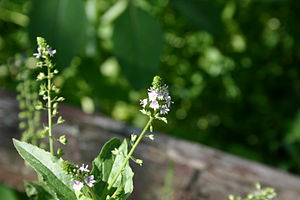- Image via Wikipedia — veronica speedwell
Speedwell is a general name given to hundreds of species in the Veronica genus in the plantain family, Plantaginaceae. Many sources will list the veronicas in the Scrophulariaceae family as re-classification of the genus continues with further study. Several species are commonly found in the Northeastern United States.
American speedwell, Veronica americana, is native to temperate Asia and North America. It is a herbaceous perennial that can be found growing in streams or on adjacent mud flats. It’s also known as American brooklime. This species has smooth, waxy stems. Axillary stems terminate in loose clusters of blue flowers. The short-stemmed leaves are oblong shaped with finely serrated edges.
Common speedwell, V. officinalis, is also known as heath speedwell for it grows in the heaths and moors of its native Old World. It has naturalized abundantly in North America and can be found growing in open grassy areas and fields. It’s also called common gypsyweed. It tends to form mats as the hairy stems reach outward from the plant center in a prostrate fashion. The flower spikes rise up vertically to show off several small white and blue flowers with dark blue lines.
Flowers of speedwell are four-petaled with two projecting stamens. Three of the petals are of similar size but the fourth petal at the lowest position is narrow. The blooms are almost always white, blue or violet, with some pink varieties available at garden centers.
In early spring the young leaves of speedwell taste like peas. They make a nice addition to spring greens salad as it goes well with dandelion, sorrel, cress, spinach or mesclun mix. Leaves grow thicker as the season goes on and they become tough and bitter, too bitter to eat when the temperatures get into the 70s. Leaves of American speedwell are probably the best tasting of all the speedwells and similar to the peppery-mustard flavor of watercress.
Tea can be made with the leaves any time of the year, but it will be extremely bitter. Add a sweetener or strong flavor to counteract the bitterness, such as orange peel or licorice root, or use it in a blend of herbs. Because of the bitterness, speedwell is not a standard herbal tea. People might drink it though for its expectorant qualities. Science confirms that a chemical called leptandrine is present in speedwell which is responsible for the expectorant properties. The presence of tannins give the leaves a tea-like smell.

